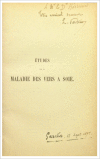Contribution of physiologists to the identification of the humoral component of immunity in the 19th century
- PMID: 28557665
- PMCID: PMC5524159
- DOI: 10.1080/19420862.2017.1325051
Contribution of physiologists to the identification of the humoral component of immunity in the 19th century
Abstract
The history of antimicrobial humoral immunity usually focuses on the works of the German school at the end of the 19th century, born in the tradition of chemistry and disinfection. Starting from an old quarrel of priority about serotherapy between Emil von Behring (1854-1917) and the French physiologists Charles Richet (1850-1935) and Jules Héricourt (1850-1938), we first confirm that the latter stated the principle of serotherapy in 1888 and put it into practice before the seminal Behring's article in 1890, observing several adverse effects of this new immunotherapy. We also find that researchers who can be considered heirs of the French school of Physiology founded by Claude Bernard (1813-1878) also investigated the field of humoral immunity in the 1870-1880s. Maurice Raynaud (1834-1881), Auguste Chauveau (1827-1917), and eventually Charles Richet applied the experimental method of Claude Bernard to the young field of microbiology, illustrating a movement called by Jacques Léonard "physiologization of the pasteurism." However, the contribution of physiologists in this field started before Louis Pasteur, leading to the conclusion that physiologists and chemists synergistically contributed to the birth of bacteriology and immunology.
Keywords: 19th century; Charles Richet (1850–1935); Emil von Behring (1854–1917); French school of physiology; Jules Héricourt (1850–1938); immunology history; serotherapy history.
Figures




References
-
- Moulin AM. Le dernier langage de la médecine: Histoire de l'immunologie de Pasteur au Sida. Paris: Presses universitaires de France; 1991.
-
- Silverstein AM. The dynamics of conceptual change in twentieth century immunology. Cell Immunol 1991; 132(2):515-31; PMID:1988166; https://doi.org/10.1016/0008-8749(91)90047-F - DOI - PubMed
-
- Silverstein AM. History of immunology. Development of the concept of immunologic specificity, I. Cell Immunol 1982; 67(2):396-409; PMID:6177425; https://doi.org/10.1016/0008-8749(82)90231-3 - DOI - PubMed
-
- Behring E, Kitasato S. Ueber das Zustandekommen der Diphtherie-Immunität und der Tetanus-Immunität bei Thieren. Dtsch Med Wochenschr 1890; 16(49):1113-4; ; https://doi.org/10.1055/s-0029-1207589 - DOI - PubMed
-
- Behring E. Untersuchungen ueber das Zustandekommen der Diphtherie-Immunität bei Thieren. Dtsch Med Wochenschr 1890; 16(50):1145-8; https://doi.org/10.1055/s-0029-1207609 - DOI - PubMed
Publication types
MeSH terms
LinkOut - more resources
Full Text Sources
Other Literature Sources
